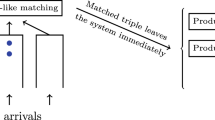Abstract
We consider the performance evaluation of circuit-switched B-ISDN networks with two traffic types of different bandwidth and holding times. Recent results have indicated that the Poisson assumption produces an optimistic evaluation of the network performance. Also, two-moment link models have been developed for use in network analysis. We investigate here the effect of two-moment methods on network performance evaluation methods based on the link decomposition technique. We extend the equivalent method of Butto to the multiservice case. We finally present some numerical studies on small networks, showing that the inclusion of two moments produces conservative evaluations, and quantify the change in performance measure brought about by the use of two-moment methods.
Similar content being viewed by others
References
J.M. Akinpelu, The overload performance of engineered networks with nonhierarchical and hierarchical routing, in:Proc. 10th Int. Teletraffic Congress, 1983, pp. 3.2.4.1–3.2.4.7.
H. Bouley, Les RNIS à commutation de circuits: calcul de la performane, variance du trafic et stabilité numérique, Master's Thesis, INRS-Télécommunications, Verdun, Québec, Canada (1991).
E. Brockmeyer, The simple overflow problem in the theory of telephone traffic, Teleteknik 5(1954)361–374 (in Danish).
M. Butto, G. Colombo and A. Tonietti, On point to point losses in communication networks, in:Proc. 8th Int. Teletraffic Congress, 1976.
L.E.N. Delbrouck, A unified approximate evaluation of congestion functions for smooth and peaky traffics, IEEE Trans. Commun. COM-29(1981)85–91.
Z. Dziong, K.Q. Liao and L. Mason, Flow control models for multiservice networks with delayed call set up, in:Proc. INFOCOM '90, Los Calamitoc, CA, 1990 (IEEE Comput. Soc. Press) pp. 39–46.
A. Girard,Routing and Dimensioning in Circuit-Switched Networks (Addison-Wesley, 1990).
A. Girard, Revenue optimization of telecommunication networks, IEEE Trans. Commun. COM-41(1993)583–591.
A. Girard and M.A. Bell, Blocking evaluation for networks with residual capacity adaptive routing, IEEE Trans. Commun. COM-37(1989)1372–1380.
A. Girard and H. Bouley, Performance evaluation of B-ISDN networks: Two-moment models and numerical stability, Technical Report 91-37, INRS-Télécommunications, Verdun, Québec, Canada (1991).
A. Girard and E.B. Gardouh, An optimization method for broadband ISDN networks, in:Proc. GLOBECOM '93, 1993, pp. 762–766.
A. Girard and E.B. Gardouh, Synthesis methods for broadband ISDN networks, in:Proc. 4th Int. Conf. on Advances in Communication and Control, 1993.
A. Girard and Y. Kassissia, Evaluation and dimensioning of multi-rate ISDN networks, in:4th Network Planning Symposium, 1989, pp. 233–239.
A. Girard and N. Lessard, Revenue optimization of virtual circuit ATM networks, in:Proc. Networks '92, 1992.
A. Girard and R. Smilga, Performance evaluation and dimensioning of circuit-switched B-ISDN networks, in:TIMS/ORSA Joint National Meeting, 1991.
A. Girard and S. St-Georges, Performance evaluation and routing optimization of ISDN networks with nonhierarchical and alternate routing, in:Proc. Telecommunication Systems Modelling and Analysis, 1993.
A. Girard and R. Zidane, Revenue optimization of B-ISDN networks, IEEE Trans. Commun., to appear.
A. Kuczura, The interrupted Poisson process as an overflow process, Bell. Syst. Tech. J. 52(1973) 437–448.
K.Q. Liao, Z. Dziong and L.G. Mason, Dynamic link bandwidth allocation in an integrated services network, in:Proc. ICC 89, 1989, pp. 977–981.
K.Q. Liao and L.G. Mason, Some further results on performance analysis for a multislot integrated service system, in:Proc. ITC-13, 1991, pp. 879–884.
K.Q. Liao and L.G. Mason, An approximate performance model for a multislot integrated services system, IEEE Trans. Commun. COM-37(1989)211–221.
L. Mason, K.Q. Liao, L. Fortier and Y. DeSerres, Performance models for a multi-slot system, in:Proc. ITC-12, ed. M. Bonatti, 1989, pp. 865–872.
J. Matsumoto and Y.U. Watanabe, Individual traffic characteristics of queuing systems with multiple Poisson and overflow inputs, IEEE Trans. Commun. COM-33(1985)1–9.
D. Medhi, A. van de Liefvoort and C.S. Reece, Performance analysis of a digital link with heterogeneous multislot traffic, Technical Report, University of Missouri-Kansas City, Kansas City, MO (1992).
Y. Nakagome and H. Mori, Flexible routing in the global communication network, in:Proc. 7th Int. Teletraffic Congress, 1973, pp. 426.1–426.8.
Traffic overflow and the interrupted Poisson process, in:Problems of Randomness in Communication Engineering (Wiley, 1984) pp. 108–118.
R. Smilga, Performance et dimensionnement des réseaux numériques à intégration de services, Master's Thesis, INRS-Télécommunications, Verdun, Québec (1990).
D.J. Songhurst, Protection against traffic overload in hierarchical networks employing alternative routing, in:Proc. Network Planning Symp., 1980.
R.I. Wilkinson, Theories for toll traffic engineering in the USA, Bell Syst. Tech. J. 35(1956) 421–514.
Author information
Authors and Affiliations
Rights and permissions
About this article
Cite this article
Girard, A., Bouley, H. Two-moment models for the performance evaluation of B-ISDN networks. Telecommunication Systems 3, 61–89 (1994). https://doi.org/10.1007/BF02110044
Received:
Revised:
Issue Date:
DOI: https://doi.org/10.1007/BF02110044




